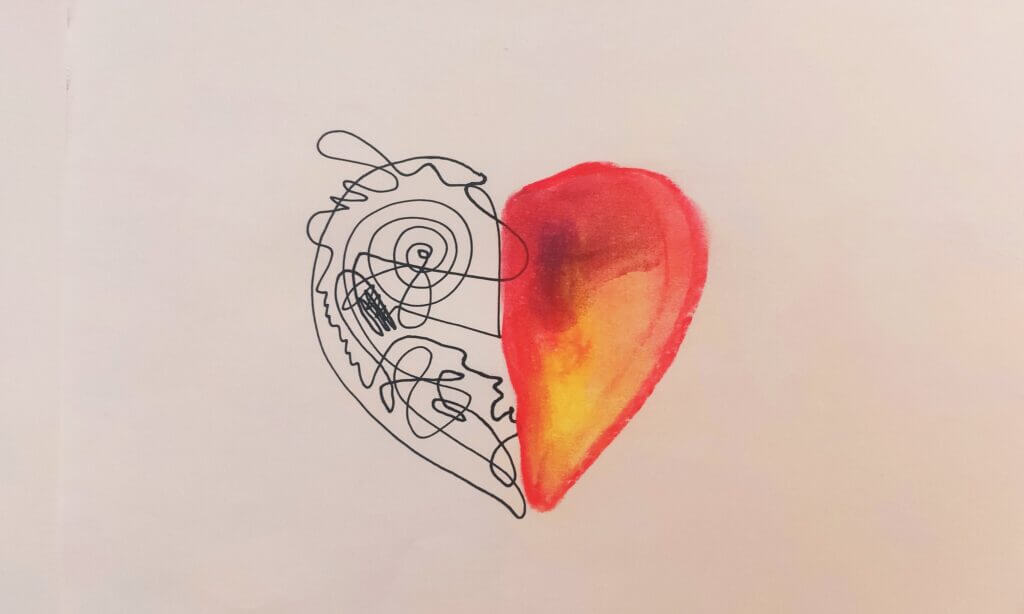One of the hardest periods of my training was when I was first helping to start our California center, OAK. There were just three of us there. Both of the people I was with, Jōshin and Kaishin, are lovely people. But it was a small townhouse, and we were spending all day together every day: meditating, cooking, eating, mopping the floor, doing fundraising.
Living in close proximity, with the pressure to actually get a monastery started, meant that there was a tremendous amount of friction. It was very, very hard. Often, I would get very angry at Jōshin and Kaishin – and usually without a very good reason.
After one argument, I hit rock bottom. The way things were just wasn’t working any more. It wasn’t working for Jōshin and Kaishin, and it wasn’t working for me. We were angry and stressed, and at the edge of our capacities as humans – and I was contributing to that.
That’s when I knew I had to make a change. I had to change my own mind. I had to become a different person for OAK to work. I didn’t know what to do, but I resolved to make whatever changes in myself I needed to for OAK to work.
Happily, I didn’t have to look far for an example of how to change. I was living with Kaishin, who was a clear example of how it could be different for me. He is one of the kindest, most loving people I have ever met.

Harrison “Kaishin” Heyl
This isn’t a surprise to anyone who knows Kaishin. When he walks into a room, you feel happier. You feel loved, and joyful, and seen. It’s a wonderful feeling.
More importantly, it’s not an accident. While Kaishin is certainly naturally inclined to be unusually kind, he’s also done extensive practice of loving kindness, or metta. He’s practiced loving kindness for years, and it shows.
Kaishin’s presence in my life gave me hope again. His example gave me the clarity that if I took up the practice of loving kindness, I would transform my mind.
So I decided to try it. I resolved to myself that I would take up the practice of loving kindness, until my mind was different, until Jōshin and I could get along and OAK was flourishing.
I spent the next three or so months doing exclusively loving kindness practice. Any time that I sat for formal meditation practice, I did loving kindness.
Regular, consistent practice of loving kindness did what I hoped it would. I stopped feeling angry and frustrated all of the time. I felt happier and clearer, and I started acting in kinder ways towards Jōshin and Kaishin.
I had been practicing meditation for about seven years. But I wish I had started doing loving kindness sooner. I believe loving kindness practice is a gentle starting place for meditation practice. It can be more effective for new meditators than other practices.
The Benefits of Cultivating Loving Kindness
When the Buddha talked about loving kindness practice, he said that it has eleven benefits:
One sleeps easily, wakes easily, dreams no evil dreams. One is dear to human beings, dear to non-human beings. The devas protect one. Neither fire, poison, nor weapons can touch one. One’s mind gains concentration quickly. One’s complexion is bright. One dies unconfused and — if penetrating no higher — is headed for the Brahma worlds. —Mettanisamsa Sutta, AN 11.16
Some of these benefits may seem strange or unlikely. You may or may not believe in reincarnation, or devas, or that loving kindness practice can protect you from physical harm.
Fortunately, contemporary science and psychological research corroborates many of the traditional benefits that are said to come from doing loving kindness practice.
According to psychological research, loving kindness practice makes it easier to feel compassion. It allows you to regulate your emotions more easily and feel less stress. Interestingly, people who practice loving kindness seem to be more inclined to serve others.
Classical Buddhist teachings and contemporary science agree that loving kindness practice is beneficial for you. Some of the benefits they claim match, such as experiencing more compassion and less stress. Other benefits diverge, like the Buddha’s claim that metta practitioners will die unconfused, or the psychological finding that loving kindness practitioners have increased grey matter volume.

If you resonate with one of those ways of looking at the world more than the other, then just know, good news: loving kindness practice is great for you.
Practicing Loving Kindness
Often, loving kindness is taught with a formulaic approach. There are certain stock phrases that you say repeatedly, such as “May you be safe and healthy. May you be free from ill will. May you be full of loving kindness. May you be truly happy.” Some people use these traditional phrases or others like them; others customize the phrases to suit their personality, needs, and circumstances.
Whatever phrases you use, you say them in your mind as you direct them towards specific people in the following order:
- yourself
- close loved ones: family and friends, or spiritual teachers
- acquaintances: people that you don’t know very well but who are in your life
- difficult relationships: people that are quite difficult for you; perhaps people who have hurt you or who it’s hard for you to love
- all life: love for all living beings, human and non-humans, past, present, and future
When I started practicing loving kindness, this is how I practiced. I used these phrases repeatedly, directing them towards myself and then others in the progression above. This is a good way to do it – it will work. But it’s not really what the heart of the technique is.
Shinzen Young compares loving kindness practice to ringing a bell. You have a mallet and a bell, and when you hit the bell, it makes a sound. What you’re really going for is the sound, but the physical objects are what you use to generate that sound.
In the same way, when you do loving kindness practice (or other forms of cultivation), you are using two things as a means to produce a certain effect: mental talk and mental images. You can use either or both mental talk and mental image – you don’t need to use both. Typically, one will be stronger or more effective for you than the other. It can also help to intentionally smile.
When you use mental talk or mental image, it will often cause an embodied reaction, like a smile or a pleasant feeling in the heart area. That’s what you’re aiming for: an embodied, positive reaction.
If and when these positive feelings arise, you can use them as a focus space, in the same way that you might with the breath or a mantra. You just stay there, feeling the feelings of love, compassion, and joy. If you get distracted, you gently return to those positive feelings.
Feeling these positive feelings can take some time. When you’re starting out, it may be solely mental, with images and talk, without very much happening in your body. That doesn’t mean you’re doing it wrong. It can take time for these feelings to really take off in the body.
Sometimes, practicing metta repeatedly can feel boring or dry. Sharon Salzberg talks about this boredom in her book, Lovingkindness. When she first helped to start the Insight Meditation Society in 1975, she planned to do a month-long self-retreat focused on loving kindness practice. She spent the first week directing loving kindness towards herself, but she “felt absolutely nothing. It was the dreariest, most boring week I had known in some time. I sat there saying, ‘May I be happy, may I be peaceful,” over and over again with no obvious result.’”
Then something unexpected happened:
someone we knew in the community had a problem, and a few of us had to leave the retreat suddenly. I felt even worse, thinking, “Not only did I spend this week doing metta and getting nothing from it, but I also never even got beyond directing metta toward myself. So on top of everything else, I was really selfish.”
I was in a frenzy getting ready to leave. As I was hurriedly getting everything together in my bathroom, I dropped a jar. It shattered all over the floor. I still remember my immediate response: “You are really a klutz, but I love you.” And then I thought, “Wow! Look at that. Something did happen in this week of practice.”
She compares the work of doing loving kindness practice to planting seeds: “As we repeat, ‘May I be happy; may all beings be happy,’ we are planting seeds by forming this powerful intention in the mind. The seed will bear fruit in its own time… the intention is enough. We form the intention in our mind for our happiness and the happiness of all.”

Mustard Seeds by Dsaikia2015 (CC BY-SA 4.0)
As Jesus of Nazareth said, the mustard seed is the smallest of seeds—but when fully grown, it becomes the largest of plants (Matthew 13:31-32). The same is true for loving kindness practice. I recommend doing at least a little loving kindness practice every day. Even a little bit goes a long way.
As you practice, pay attention to how doing loving kindness changes your life. For example, the way you interact with people you send loving kindness to might change. It might be easier to be kind to them, or to speak in kind ways. Notice any positive changes that happen, and enjoy them.
Loving All Beings
Shortly after I started doing loving kindness practice at OAK, I had an interview with my teacher, Soryu.
I described how my practice was going – that I was sending love to myself, my friends and family, my acquaintances, and my enemies.
Then Soryu said something that took me by surprise. He said something like, “Well, that’s good, but what about compassion for all beings?”
In retrospect, I think: of course he would say that. That’s what his name, Forall, means: he is someone who claims to be living for the benefit of all life.
Soryu’s question prompted me to realize that I had only been sending love to other humans (and usually humans that I knew). I had forgotten about the non-humans: about the animals and the plants and the other life forms on this planet.
This tendency is common for us as humans. Our perceptions and our behavior are self-centered. We choose ourselves, and our comfort, over others. We may not do it intentionally, but we do it just the same.
Loving kindness practice invites us to move beyond this harmful view by giving us the opportunity to cultivate love for other species, and ultimately for all life.
Through loving kindness practice, we cultivate the view that all life deserves love, happiness, and care. And we can cultivate the story: I love all life.
This is the view, the story, that heals the wounds that we are inflicting upon the world today. We are hurting the world with our view that humans are all that matter. We can heal the world with the view that all life matters. All life matters: not just human lives, but also the plants, the animals, the trees, the whole dancing ecosystem that feeds us, holds us, lets us live and lets us die.
Loving kindness is a way to practice seeing from this perspective that all life matters: not just humans, and not just the people that we know, but all life. That’s the story that we need to tell now.
U might also enjoy reading my book on loving-kindness and the brahmavihārās, The Path of Love.
Further Resources
- Weekly Guided Metta Meditations Online with Tasshin
- The Path of Love, a short book I wrote on loving kindness practice and the brahmavihārās
- Guided Lovingkindness Meditations from Tasshin
- Metta Sutra
- Shinzen Young on Becoming a High-Wattage Broadcaster of Human Positivity
- Christopher Titmuss on U Pandita Teaching Metta in the West
Thanks to Colin Bested for his help drafting this article, and to Stephen Torrence, Bekah Byer, and Thomas Bonn for providing feedback on this post. Special thanks to Harrison “Kaishin” Heyl for inspiring me to do loving kindness practice.
The art in this post was created by Sílvia Bastos, and is licensed under a CC BY-NC-SA 4.0 license. You can support her work on Patreon.

